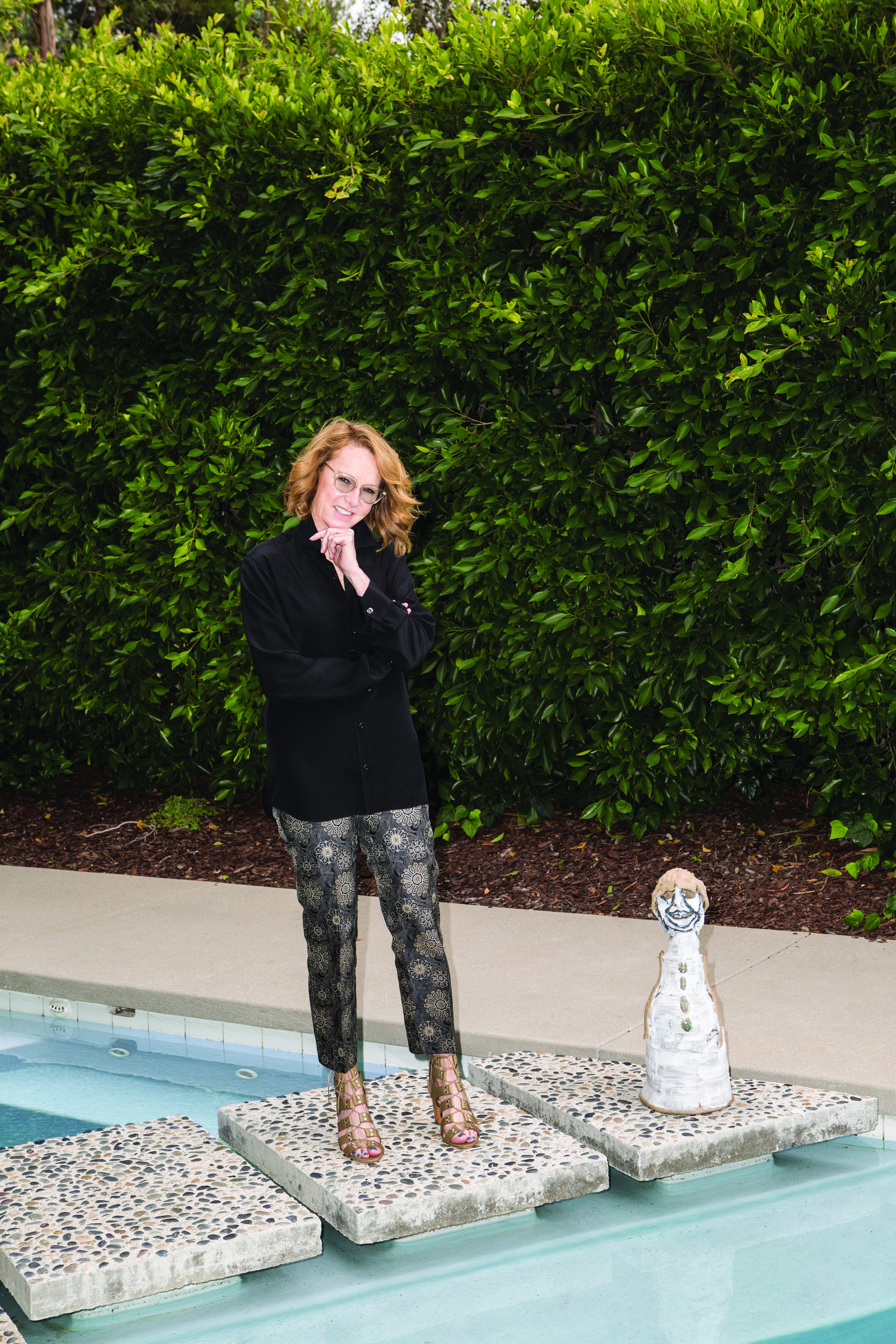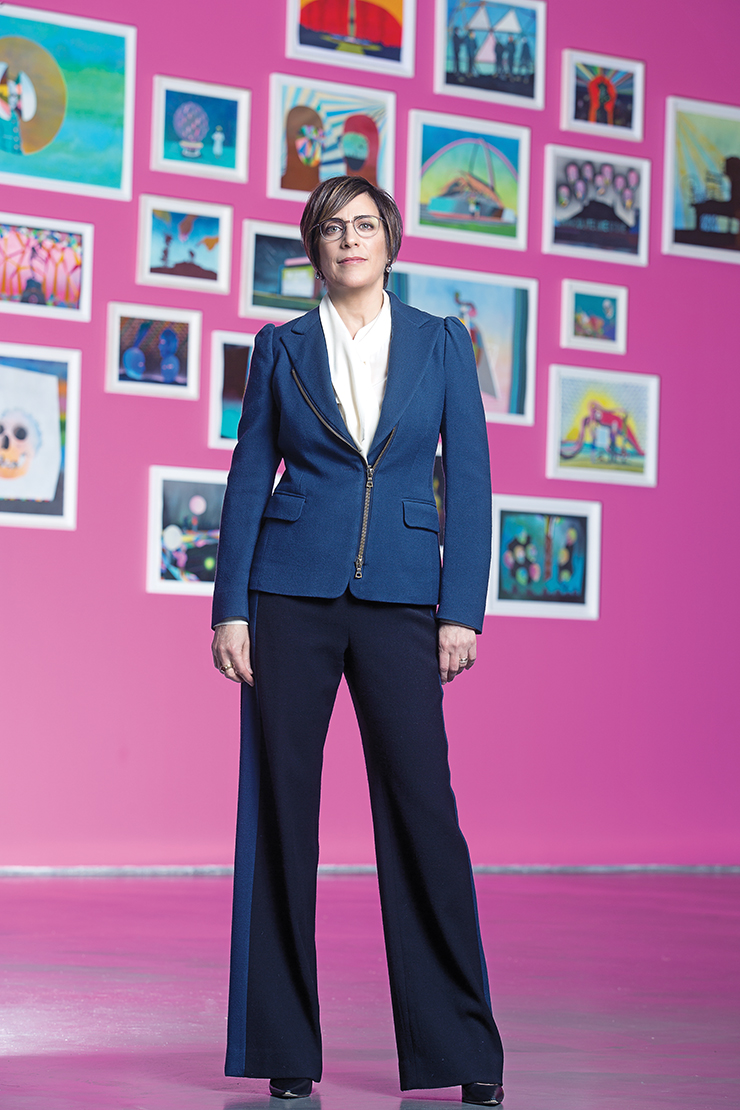
Pamela Joyner is “the Diana Ross of the art world,” says artist Isaac Julien. “She is glamorous but also smart and genuine. She is helping to give a voice to artists of African descent through her collecting.” Joyner, a Harvard M.B.A. and former investment manager with a flamboyant fashion sense, is on President Obama’s Committee of the Arts and Humanities.
She is also a trustee of the Art Institute of Chicago and the Tate Americas Foundation, as well as a significant patron of museums elsewhere. Fred Giuffrida, her husband of 12 years, is the managing director of a private equity investment firm. He supports the collection as a “limited partner,” leaving the day-to-day decisions to Joyner.
Joyner and Giuffrida have homes in San Francisco, Sonoma and New York, all jam-packed with art. Their collection includes more than 300 works by African-American artists, with a few dozen works by African and Afro-Caribbean artists. Unusually, the bulk of the collection is Abstract. It includes celebrated mid-career artists such as Mark Bradford, Glenn Ligon and Julie Mehretu as well as lesser-known Abstract Expressionists like Richard Mayhew, Sam Gilliam and Norman Lewis.

Joyner’s mission is not just to find excellence where it has been overlooked but to also have a positive impact on the history of art. Much like the now defunct expectation that women artists would make women’s work, the art world of the 1970s and 1980s tended to reward African-American artists who made figurative work that explicitly addressed black lives. “Given the political backdrop for African-Americans during those years, the fact that Sam Gilliam defied expectations and worked for decades only in abstraction is really subversive,” explains Joyner. “The practices of these artists were as authentic as can be because there was no likelihood of recognition or compensation.”
Bob Rennie, whose museum-caliber Rennie Collection is open to the public in Vancouver, is an admirer of Joyner’s methods. “Pamela has really taken on custodianship of these artists who have fallen through the cracks because of their race,” he says. “It is important that they are part of the conversation. Whether they are leaders or followers, we will find out in 25 to 50 years. We collectors don’t have to be right about everyone all of the time.”
Joyner sees herself as a “poster child for early childhood arts education.” Her parents left the Jim Crow South for the relatively hospitable city of Chicago. Her father eventually taught history at a junior college while her mother became an English teacher at a Catholic high school. “I was raised by parents who sought to provide me with tools that would enable me to achieve anything,” explains Joyner, who visited the Art Institute of Chicago regularly after her music and ballet lessons. “Being cultured was very much a part of my upbringing,” she adds. “It was one of the ways that my parents imbued me with the notion that I faced absolutely no limitations.”

Joyner went to Dartmouth, then Harvard, where she found herself to be one of nine African-American women in a class of around 800. “I put on blinders and had tunnel vision,” she admits. “At Harvard Business School in those days, you were evaluated based on your contribution in class. We were advised to speak up. I’m not a shrinking violet, so that wasn’t hard for me, but for some women the testosterone in the room made it difficult.”
The style of Joyner and Giuffrida’s collecting emerges from their common experience in the investment business. “Business brought us together,” says Joyner. “Both of us think that group and committee decisions are generally not the most effective ones. If you look at buildings or any endeavors designed by committees, they’re usually pretty mediocre and unattractive.” While Joyner drives the collection, Giuffrida weighs in on budgetary matters and asks key questions about enduring value and iconicity. The couple relishes their complementarity. “Pam is a consummate entrepreneur. She starts things that I would never take on because they seem too monumental,” explains Giuffrida. “I’m more of a manager. Entrepreneurs sometimes leave wakes in their path. I help by managing some of that.”
 Norman Lewis
Norman LewisAmerican, 1909-1979
Afternoon, 1969
Oil on canvas
182.9 x 223.5 cm (72 x 88 in.)
Collection of Pamela Joyner
14.2014
American, 1909-1979
Afternoon, 1969
Oil on canvas
182.9 x 223.5 cm (72 x 88 in.)
Collection of Pamela Joyner
14.2014
The Art Institute of Chicago
One of many business insights that Joyner has brought with her to the art world is that people and relationships matter. As a result, their collecting operates alongside deep museum involvement. Likewise, their new book, “Four Generations: The Joyner/Giuffrida Collection of Abstract Art,” edited by Courtney J. Martin, an assistant professor of the history of art and architecture at Brown University, is written by a who’s who of dynamic, well-connected curators. “That group of authors is by and large Pam’s network for information writ large, which comes from so many institutions and so many different vantage points,” explains Giuffrida. “Pam has always been good at convening and building these relationships.”
The New York launch of “Four Generations” was a formal dinner for 200 held in the penthouse of Midtown Manhattan’s Hearst Tower. “I wanted it to be a love letter to the artists who enrich our lives,” says Joyner. “The black tie invitation was meant to signal a serious event and give me an excuse to wear the dresses that are already in my closet,” she adds with a laugh. Joyner was also knowingly bringing together a village of curators, dealers, museum directors and art historians who have the power to endorse these artists in a way no single collector could ever do on her own. The event was also dotted with fellow collectors. “We are having the time of our lives,” admits Joyner. “We want to encourage other people to find an underrepresented story and tell it.”
An exhibition of the highlights of the Joyner/Giuffrida Collection will open at the Ogden Museum of Southern Art in New Orleans in October 2017.






